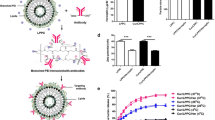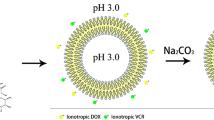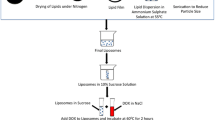Abstract
Gemcitabine (2′,2′-difluorodeoxycytidine, GCT) is an analog of deoxycytidine with cytotoxicity for breast cancer cells. However, because of its hepatotoxicity and other side effects, an efficient drug delivery system is needed for better therapeutic outcomes. A temperature-sensitive PEGylated immunoliposome (TSL) with trastuzumab (or Herceptin) attached encapsulating GCT (Her-PEG-TSL-GCT) was prepared. The mean diameter of the liposome was about 200 nm and the prepared immunoliposome showed the capacity to deliver the payload to the hyperthermic environment. The actual number of antibody molecules attached to one single liposome is about 19, with the GCT encapsulation efficiency of 54.6 ± 3.50 %. This immunoliposome shows a temperature-dependent drug release at around 41–43 °C. Anticancer activity of Her-PEG-TSL-GCT was determined using HER-2 expressing breast cancer cells, SK-BR-3, in vitro and resulted in increased cytotoxicity compared to free GCT (IC20 11.7 nM) or conventional liposome lacking the targeting antibody. In conclusion, these data show that improved delivery of GCT to breast cancer cells can be achieved by Her-PEG-TSL-GCT in vitro, and this strategy could be used for breast cancer therapy with further studies.






Similar content being viewed by others
References
Abu Samah NH, Heard CM (2013) Enhanced in vitro transdermal delivery of caffeine using a temperature- and pH-sensitive nanogel, poly(NIPAM-co-AAc). Int J Pharm 453:630–640
Allen TM, Hansen C, Martin F, Redemann C, Yau-Young A (1991) Liposomes containing synthetic lipid derivatives of poly(ethylene glycol) show prolonged circulation half-lives in vivo. Biochim Biophys Acta 1066:29–36
Bartlett GR (1959) Phosphorus assay in column chromatography. J Biol Chem 234:466–468
Beeghly-Fadiel A, Kataoka N, Shu XO, Cai Q, Deming SL, Gao YT, Zheng W (2008) Her-2/neu amplification and breast cancer survival: results from the Shanghai breast cancer study. Oncol Rep 19:1347–1354
Bharat A, Aft RL, Gao F, Margenthaler JA (2009) Patient and tumor characteristics associated with increased mortality in young women (≤40 years) with breast cancer. J Surg Oncol 100:248–251
Bligh EG, Dyer WJ (1959) A rapid method of total lipid extraction and purification. Can J Biochem Physiol 37:911–917
Bradford MM (1976) A rapid and sensitive method for the quantitation of microgram quantities of protein utilizing the principle of protein-dye binding. Anal Biochem 72:248–254
Bunn PA Jr, Helfrich B, Soriano AF, Franklin WA, Varella-Garcia M, Hirsch FR, Baron A, Zeng C, Chan DC (2001) Expression of Her-2/neu in human lung cancer cell lines by immunohistochemistry and fluorescence in situ hybridization and its relationship to in vitro cytotoxicity by trastuzumab and chemotherapeutic agents. Clin Cancer Res 7:3239–3250
Caliceti P, Veronese FM (2003) Pharmacokinetic and biodistribution properties of poly(ethylene glycol)-protein conjugates. Adv Drug Deliv Rev 55:1261–1277
Carmichael J, Walling J (1997) Advanced breast cancer: investigational role of gemcitabine. Eur J Cancer 33(Suppl 1):S27–S30
Choi M, Shin DH, Kim J (2013) Repositioning of zoledronic acid for breast cancer using transferrin-conjugated liposome. J Pharm Investig 43:461–469
Delgado C, Patel JN, Francis GE, Fisher D (1990) Coupling of poly(ethylene glycol) to albumin under very mild conditions by activation with tresyl chloride: characterization of the conjugate by partitioning in aqueous two-phase systems. Biotechnol Appl Biochem 12:119–128
Du H, Chandaroy P, Hui SW (1997) Grafted poly-(ethylene glycol) on lipid surfaces inhibits protein adsorption and cell adhesion. Biochim Biophys Acta 1326:236–248
Engel RH, Kaklamani VG (2007) HER2-positive breast cancer: current and future treatment strategies. Drugs 67:1329–1341
Francis GE, Delgado C, Fisher D, Malik F, Agrawal AK (1996) Polyethylene glycol modification: relevance of improved methodology to tumour targeting. J Drug Target 3:321–340
Gamucci O, Bertero A, Bardi MGG (2014) Biomedical nanoparticles: overview of their surface immune-compatibility. Coatings 4:139–159
Gazzaniga P, Silvestri I, Gradilone A, Scarpa S, Morrone S, Gandini O, Gianni W, Frati L, Agliano AM (2007) Gemcitabine-induced apoptosis in 5637 cell line: an in vitro model for high-risk superficial bladder cancer. Anticancer Drugs 18:179–185
Grunewald R, Abbruzzese JL, Tarassoff P, Plunkett W (1991) Saturation of 2′,2′-difluorodeoxycytidine 5′-triphosphate accumulation by mononuclear cells during a phase I trial of gemcitabine. Cancer Chemother Pharmacol 27:258–262
Heinemann V, Xu YZ, Chubb S, Sen A, Hertel LW, Grindey GB, Plunkett W (1992) Cellular elimination of 2′,2′-difluorodeoxycytidine 5′-triphosphate: a mechanism of self-potentiation. Cancer Res 52:533–539
Howlader N, Noone AM, Yu M, Cronin KA (2011) Use of imputed population-based cancer registry data as a method of accounting for missing information: application to estrogen receptor status for breast cancer. Am J Epidemiol 176:347–356
Israelachvili JN, Mitchell DJ (1975) A model for the packing of lipids in bilayer membranes. Biochim Biophys Acta 389:13–19
Jang M, Yoon YI, Kwon YS, Yoon TJ, Lee HJ, Hwang SI, Yun BL, Kim SM (2014) Trastuzumab-conjugated liposome-coated fluorescent magnetic nanoparticles to target breast cancer. Korean J Radiol 15:411–422
Jemal A, Siegel R, Xu J, Ward E (2010) Cancer statistics, 2010. CA Cancer J Clin 60:277–300
Juweid M, Neumann R, Paik C, Perez-Bacete MJ, Sato J, van Osdol W, Weinstein JN (1992) Micropharmacology of monoclonal antibodies in solid tumors: direct experimental evidence for a binding site barrier. Cancer Res 52:5144–5153
Kirpotin D, Park JW, Hong K, Zalipsky S, Li WL, Carter P, Benz CC, Papahadjopoulos D (1997) Sterically stabilized anti-HER2 immunoliposomes: design and targeting to human breast cancer cells in vitro. Biochemistry 36:66–75
Klibanov AL, Maruyama K, Torchilin VP, Huang L (1990) Amphipathic polyethyleneglycols effectively prolong the circulation time of liposomes. FEBS Lett 268:235–237
Li SD, Huang L (2009) Nanoparticles evading the reticuloendothelial system: role of the supported bilayer. Biochim Biophys Acta 1788:2259–2266
Ludovini V, Gori S, Colozza M, Pistola L, Rulli E, Floriani I, Pacifico E, Tofanetti FR, Sidoni A, Basurto C, Rulli A, Crino L (2008) Evaluation of serum HER2 extracellular domain in early breast cancer patients: correlation with clinicopathological parameters and survival. Ann Oncol 19:883–890
Maeda H (2001) The enhanced permeability and retention (EPR) effect in tumor vasculature: the key role of tumor-selective macromolecular drug targeting. Adv Enzym Regul 41:189–207
Maruyama K, Unezaki S, Takahashi N, Iwatsuru M (1993) Enhanced delivery of doxorubicin to tumor by long-circulating thermosensitive liposomes and local hyperthermia. Biochim Biophys Acta 1149:209–216
Matsumura Y, Maeda H (1986) A new concept for macromolecular therapeutics in cancer chemotherapy: mechanism of tumoritropic accumulation of proteins and the antitumor agent smancs. Cancer Res 46:6387–6392
Pegram MD, Finn RS, Arzoo K, Beryt M, Pietras RJ, Slamon DJ (1997) The effect of HER-2/neu overexpression on chemotherapeutic drug sensitivity in human breast and ovarian cancer cells. Oncogene 15:537–547
Pegram MD, Konecny GE, O’Callaghan C, Beryt M, Pietras R, Slamon DJ (2004) Rational combinations of trastuzumab with chemotherapeutic drugs used in the treatment of breast cancer. J Natl Cancer Inst 96:739–749
Ramirez de Molina A, Gutierrez R, Ramos MA, Silva JM, Silva J, Bonilla F, Sanchez JJ, Lacal JC (2002) Increased choline kinase activity in human breast carcinomas: clinical evidence for a potential novel antitumor strategy. Oncogene 21:4317–4322
Reese DM, Slamon DJ (1997) HER-2/neu signal transduction in human breast and ovarian cancer. Stem Cells 15:1–8
Reynolds JG, Geretti E, Hendriks BS, Lee H, Leonard SC, Klinz SG, Noble CO, Lucker PB, Zandstra PW, Drummond DC, Olivier KJ Jr, Nielsen UB, Niyikiza C, Agresta SV, Wickham TJ (2012) HER2-targeted liposomal doxorubicin displays enhanced anti-tumorigenic effects without associated cardiotoxicity. Toxicol Appl Pharmacol 262:1–10
Saif MW (2010) Pulmonary toxicity associated with gemcitabine. JOP 11:189–190
Seshadri R, Firgaira FA, Horsfall DJ, McCaul K, Setlur V, Kitchen P (1993) Clinical significance of HER-2/neu oncogene amplification in primary breast cancer. The South Australian Breast Cancer Study Group. J Clin Oncol 11:1936–1942
Shin DH, Xuan S, Kim WY, Bae GU, Kim JS (2014) CD133 antibody-conjugated immunoliposomes encapsulating gemcitabine for targeting glioblastoma stem cells. J Mater Chem B 2:3707–3898
Shmeeda H, Tzemach D, Mak L, Gabizon A (2009) Her2-targeted pegylated liposomal doxorubicin: retention of target-specific binding and cytotoxicity after in vivo passage. J Control Release 136:155–160
Slamon DJ, Leyland-Jones B, Shak S, Fuchs H, Paton V, Bajamonde A, Fleming T, Eiermann W, Wolter J, Pegram M, Baselga J, Norton L (2001) Use of chemotherapy plus a monoclonal antibody against HER2 for metastatic breast cancer that overexpresses HER2. N Engl J Med 344:783–792
Smigal C, Jemal A, Ward E, Cokkinides V, Smith R, Howe HL, Thun M (2006) Trends in breast cancer by race and ethnicity: update 2006. CA Cancer J Clin 56:168–183
Szoka F Jr, Papahadjopoulos D (1978) Procedure for preparation of liposomes with large internal aqueous space and high capture by reverse-phase evaporation. Proc Natl Acad Sci USA 75:4194–4198
Teske E, Rutteman GR, van Heerde P, Misdorp W (1990) Polyethylene glycol-l-asparaginase versus native l-asparaginase in canine non-Hodgkin’s lymphoma. Eur J Cancer 26:891–895
Torchilin VP (2005) Recent advances with liposomes as pharmaceutical carriers. Nat Rev Drug Discov 4:145–160
Toschi L, Finocchiaro G, Bartolini S, Gioia V, Cappuzzo F (2005) Role of gemcitabine in cancer therapy. Futur Oncol 1:7–17
van Engeland M, Nieland LJ, Ramaekers FC, Schutte B, Reutelingsperger CP (1998) Annexin V-affinity assay: a review on an apoptosis detection system based on phosphatidylserine exposure. Cytometry 31:1–9
Weinstein JN, Magin RL, Yatvin MB, Zaharko DS (1979) Liposomes and local hyperthermia: selective delivery of methotrexate to heated tumors. Science 204:188–191
Acknowledgments
This research was supported by the Sookmyung Women’s University Research Grant (2015).
Author information
Authors and Affiliations
Corresponding author
Ethics declarations
Conflict of interest
All authors (Dae Hwan Shin, Min-Ji Koo, Jung Seok Kim and Jin-Seok Kim) declare that they have no conflict of interest.
Additional information
Dae Hwan Shin and Min-Ji Koo have contributed equally to this work as a first author.
Rights and permissions
About this article
Cite this article
Shin, D.H., Koo, MJ., Kim, J.S. et al. Herceptin-conjugated temperature-sensitive immunoliposomes encapsulating gemcitabine for breast cancer. Arch. Pharm. Res. 39, 350–358 (2016). https://doi.org/10.1007/s12272-016-0707-y
Received:
Accepted:
Published:
Issue Date:
DOI: https://doi.org/10.1007/s12272-016-0707-y




